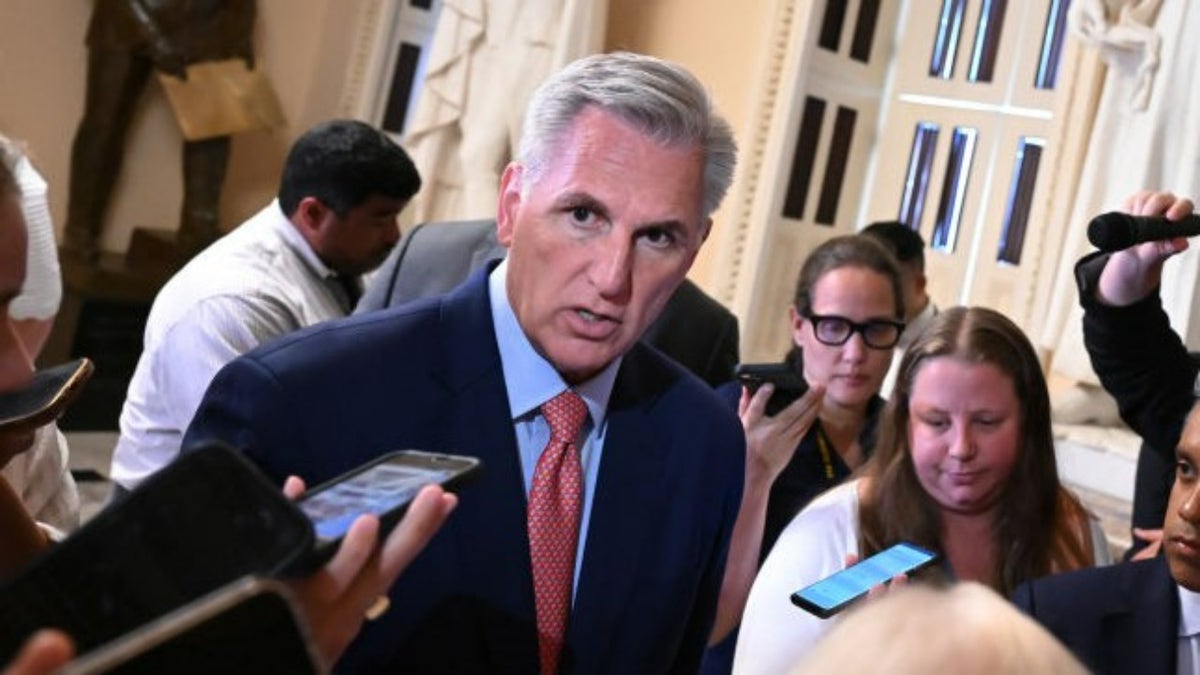Government funding expires at 11:59:59 pm et on September 30.
And right now, House Republicans, despite holding the majority, can’t pass any spending bills by themselves.
The House has tried for two weeks to get clearance on a procedural vote for the House to even launch debate on a defense spending bill. That’s a measure most Republicans support. In fact House Speaker Kevin McCarthy, R-Calif., says he’s never heard a Republican articulate what’s wrong with the bill.
Republicans passed one of the 12 annual spending bills in July. And now Republicans have practically torpedoed their trial balloon package rolled out over the weekend. That plan would re-up government funding to avoid a shutdown for 31 days and attach language to bolster border security. The House had planned to vote on that bill Thursday.
It was a bad omen for a potential government shutdown when Republicans blew up their own procedural vote, blocking the House from beginning debate on the defense bill Tuesday.
‘Is this another blow to you,’ yours truly asked McCarthy.
‘You think it’s a blow. I just think it’s another challenge,’ replied McCarthy.
‘Most Speakers are able to get their defense bills onto the floor,’ I countered.
‘You assume it’s over,’ responded McCarthy. ‘I don’t quit.’
McCarthy then warned that he would keep everyone here this weekend to vote.
‘We’re going to vote on appropriations bills, whether they pass them or not,’ said McCarthy.
That is, if they can even bring them to the floor.
The votes have never caramelized for McCarthy in his efforts to get any spending measure up for debate recently.
And therein lies the potential strategy for McCarthy.
It may look like defeat after defeat after defeat for McCarthy. And it is. But McCarthy has long-known where the solution to this impasse lies. The government may shut down. But the only path to keep the government open is a blend of Democrats and Republicans in the House and Senate. In fact, an interim spending bill to avert a shutdown could likely clear the Senate with 65 to 70 votes. A similar bill would move through the House with anywhere between 275 to 300-plus votes. For reference, the House approved the bill to suspend the debt ceiling in May with 314 votes.
But McCarthy can’t pivot just yet to something else. He has to let his own GOP members fight it out among themselves. That’s why he gave a wide berth to the more centrist Republican ‘Main Street’ Caucus and Rep. Scott Perry, R-Penn., the head of the Freedom Caucus, to cut a deal on the interim spending bill over the weekend. But that plan appears dead.
Nothing can pass the House right now. And, ironically, that might be what McCarthy needs.
To wit: McCarthy keeps the House here to vote on rules to bring up various procedural matters or the bills themselves. In the process, McCarthy is building a canon of evidence to show that there are 200-plus Republicans willing to vote yes on something – and a crew of five to 20 who will oppose just about anything.
It’s often a bad idea on Capitol Hill to keep members in Washington over a weekend when there aren’t things to pass or items to vote on. Lawmakers grow cranky and insolent. They sometimes then lash out at leadership for marooning them in Washington with little to show for it. In the case of the Freedom Caucus members, leaders have sometimes wanted to separate them. So tethering lawmakers to Washington with little to do often backfires.
But here, McCarthy may actually want people in Washington. It helps members hash things out and conjure their own ideas to end the standoff. McCarthy has publicly said he prefers to defer to Members. But heretofore, that approach hasn’t worked.
In addition, it’s about the math.
In the sense that there are about 200 Republicans who fully support McCarthy and five to 20 who aren’t completely on board. There is strength in numbers. The stasis in the House will start to draw the ire of the larger group. They already feel that the most extreme voices in the GOP are dragging the majority around by the nose. So, one could see infighting between McCarthy loyalists and those who oppose him.
So what happens if the spending measures fail in the coming days? McCarthy will have shown that he was willing to fight and ‘never give up,’ as he often says. But the Speaker warned rank-and-file Republicans for days that unless the House passes something, it will likely get jammed by the Senate.
Since McCarthy can’t get votes to caramelize around any proposal to avoid a shutdown, it’s possible the Senate could cobble together an interim spending bill. That involves a lot of parliamentary mechanics. In fact, it may already be too late for the Senate to assemble a stopgap bill and break two filibusters to avoid a shutdown on October 1. But things are definitely a lot better these days in the Senate than the House.
If that’s the case, McCarthy can tell his members that he tried and the House weakened its position by never passing a bill of consequence in the spending fight. Therefore, the House must accept whatever the Senate comes up with.
This inherently weakens McCarthy’s stance. We don’t know if a government shutdown is inevitable. But it’s a near certainty that Rep. Matt Gaetz, R-Fla., or someone else will call for a no confidence vote in McCarthy’s leadership.
This is known as a ‘motion to vacate the chair.’ And while I’ve seen a lot of Congressional ‘shows’ over the years, this program has never appeared in my TV Guide.
A ‘motion to vacate’ could happen at any time – although it’s more likely to unfold if and when the House adopts an interim spending bill. A ‘CR’ (short for Continuing Resolution, because it renews all old funding at present levels) appears to be the red line for McCarthy’s opponents.
Here’s what happens if we get a ‘motion to vacate.’
All it takes is one Member to call for a ‘motion to vacate.’ However, that motion is subject to a SECONDARY motion. McCarthy defenders would probably move to table (set aside) or refer the PRIMARY motion to committee (probably House Rules or Administration). If the SECONDARY motion prevails, the effort to ‘vacate the chair’ is euthanized. There’s no threat to McCarthy.
But if the House DEFEATS the SECONDARY motion, the House then votes on the PRIMARY motion (the motion to vacate). If the House okays the motion to vacate, hold on to your hats.
All legislative traffic on the House floor stops. We are essentially back to January 3, the beginning of the Congress. The House can’t do anything on the floor until it elects a Speaker. Remember that it took 15 rounds in January to pick a Speaker. That process consumed five days and was the longest Speaker’s election since 1859. A potential Speaker’s race at this stage could take longer.
Remember, the winning candidate must receive an outright majority of all Members of the House WHO VOTE.
That said, the House is in a different situation than it was in January. The House has sworn-in its Members. It has committees. So other activity may continue. But NOTHING on the floor until it picks a Speaker.
Here is the doomsday scenario:
The government shuts down and the House is forced into an election for Speaker. But then the House struggles to elect a Speaker – EVEN IF IT HAS THE VOTES TO RE-OPEN THE GOVERNMENT.
Sigh.
Keep in mind that if the government shutters, it deems certain workers as ‘essential.’ But things like national parks close. And workers who are on the job aren’t paid. In fact, Congress usually must approve a resolution to provide back-pay to federal workers if they miss a paycheck.
Border Patrol, the Transportation Security Agency and air traffic controllers are required to work – even if they aren’t paid. However, air safety was one of the reasons the government re-opened in 2019 after a 35-day government shutdown which began in late 2018.
A small group of air traffic controllers decided to stay home – paralyzing travel at major air hubs like Philadelphia, Atlanta, Newark, N.J., and at New York’s La Guardia airport.
That ‘sickout’ compelled the Trump Administration to relent and re-open the government.
Most lawmakers from both parties now believe the government is cruising toward a shutdown. The question is what are the aftershocks on Capitol Hill and for the Speaker.























